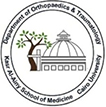Knee Anatomy

Ligaments
Large ligaments, each with a particular function, are attached to the knee to provide stability.
These are the Medial Collateral Ligament (MCL) which attaches to and runs between the inner (medial) surfaces of the femur and tibia. The innermost band is attached to the medial meniscus. The MCL prevents the knee from collapsing inwards and protects the knee from valgus or outwards forces.
The Lateral Collateral Ligament (LCL joins the outer (lateral) surface of the femur to the head of the fibula. It resists impact from the inner surface of the knee known as a varus force.
The Anterior Cruciate Ligament (ACL) and the Posterior Cruciate Ligament (PCL) are a pair of stabilizing ligaments located in the center of the knee. They are strong rope like structures connecting the femur to the tibia through the intercondylar notch. The ACL and PCL prevent the femur from abnormal sliding and rotating movements on the tibia. One of the main functions of the ACL is to provide stability during rotational movements such as turning, twisting, and sidestepping. The PCL attaches posterior to the ACL and prevents the knee being forced backwards (hyperextension)


Articular Cartilage and Menisci
The movement of the bones causes friction between the articulating surfaces. To reduce this friction, all articulating surfaces involved in movement are covered with a white, shiny, slippery layer called articular cartilage. The articulating surface of the femoral condyles, tibial plateaus, and the back of the patella are covered with this cartilage. The cartilage provides a smooth surface that facilitates easy movement.
To further reduce friction between the articulating surfaces of the bones, the knee joint is lined by a synovial membrane which produces a thick clear fluid called synovial fluid. This fluid lubricates and nourishes the cartilage and bones inside the joint capsule.
Within the knee joint between the femur and tibia, there are two C shaped cartilaginous structures called menisci. Menisci function to provide stability to the knee by spreading the weight of the upper body across the whole surface of the tibial plateau. The menisci help in load bearing by preventing the weight from concentrating onto a small area, which could damage the articular cartilage. The menisci also act as a cushion between the femur and tibia by absorbing the shock produced by activities such as walking, running and jumping.
Muscles and tendons
The two main muscle groups of the knee joint are the quadriceps and the hamstrings. Both play a vital role in moving and stabilizing the knee joint and providing strength.
The quadriceps muscle group is made up of four different individual muscles which join together forming the quadriceps tendon. This thick tendon connects the muscle to the patella which in turn connects to the tibia via the patellar tendon. Contraction of the quadriceps pulls the patella upwards and extends the knee. The quadriceps muscles consist of the rectus femoris, vastus medialis, vastus intermedius, and vastus lateralis muscles.
The hamstring muscles at the back of the thigh function to flex or bend the knee as well as providing stability on either side of the joint line. The hamstring muscles consist of the biceps femoris, semitendinosus and semimembranosus, and gracilis.





